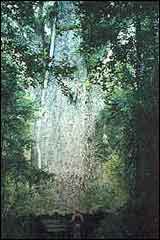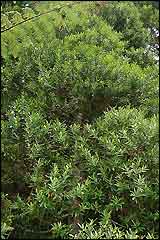|
|
|||
|
||||
|
Updated: September 12, 2001 |
|
|
|||||||||||||||||||||||||||||||||||||||||||||||||||||||||||||||||||||||||||||||
 The trunk of a kauri tree can be up to 16 metres around |
|
 This young kauri tree is just over 50 years old |
Kauri are an endemic conifer pine found in the northern third of the North Island. They grow from sea level to 600m. Kauri (Agathis Australis) belong to the family Araucariaceae. They are the only species of this very ancient family found in New Zealand. Other examples are found in the South-western pacific including Australia and New Guinea.
For the first 50 years of a kauri tree's life it is in a cone shape. From then on a solid trunk forms with a crown of branches from above 15 - 20m. They reach maturity at around 200 years but are still growing at 500 years old.
Kauri are one of the few native trees that are non-flowering. They are a type of gymnosperm (have a naked seed) with the seeds found in cones. The female cones are round in shape and the male cones are finger-shaped. The female cones mature in March and the seeds are quick to germinate as long as there is good light. Male and female cones are found on the same tree and they can be self-fertilised or the wind can blow the pollen from another tree. The seeds are also spread via the wind.
The trunk of a kauri tree has grey coloured bark which flakes off in round pieces leaving flat marks - like hammer marks. Occasionally on the trunk there will be fresh gum bleeding from the tree.
The kauri is a host tree to many shrubs and tufting plants that live high up in the crown of the tree.